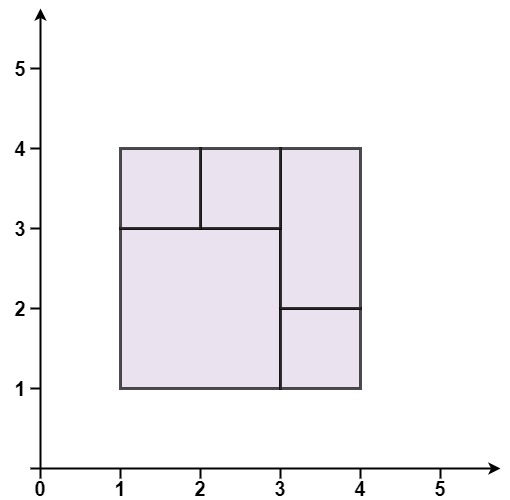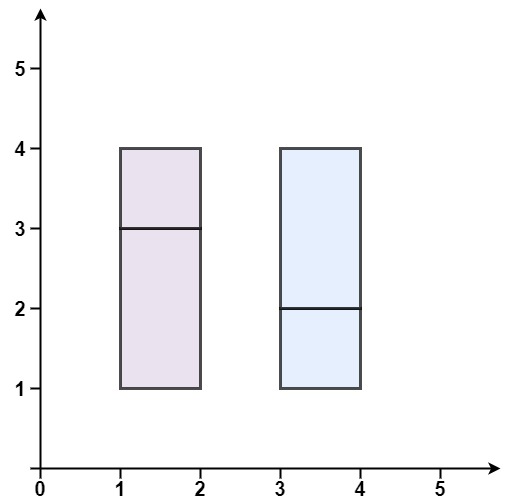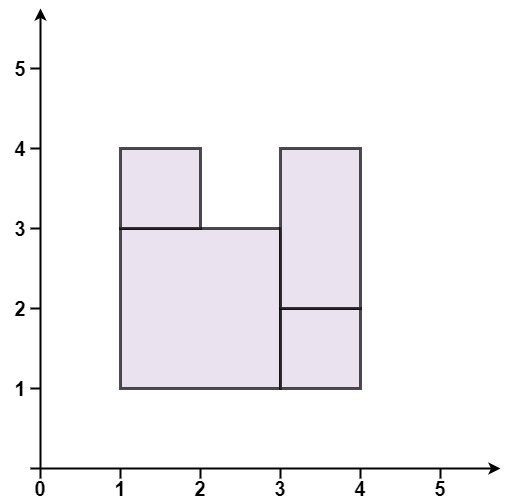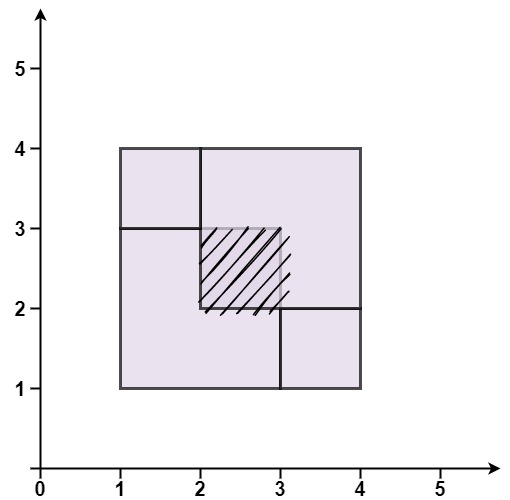LeetCode-in-Java
391. Perfect Rectangle
Hard
Given an array rectangles where rectangles[i] = [xi, yi, ai, bi] represents an axis-aligned rectangle. The bottom-left point of the rectangle is (xi, yi) and the top-right point of it is (ai, bi).
Return true if all the rectangles together form an exact cover of a rectangular region.
Example 1:

Input: rectangles = [[1,1,3,3],[3,1,4,2],[3,2,4,4],[1,3,2,4],[2,3,3,4]]
Output: true
Explanation: All 5 rectangles together form an exact cover of a rectangular region.
Example 2:

Input: rectangles = [[1,1,2,3],[1,3,2,4],[3,1,4,2],[3,2,4,4]]
Output: false
Explanation: Because there is a gap between the two rectangular regions.
Example 3:

Input: rectangles = [[1,1,3,3],[3,1,4,2],[1,3,2,4],[3,2,4,4]]
Output: false
Explanation: Because there is a gap in the top center.
Example 4:

Input: rectangles = [[1,1,3,3],[3,1,4,2],[1,3,2,4],[2,2,4,4]]
Output: false
Explanation: Because two of the rectangles overlap with each other.
Constraints:
1 <= rectangles.length <= 2 * 104rectangles[i].length == 4-105 <= xi, yi, ai, bi <= 105
Solution
import java.util.HashSet;
import java.util.Objects;
import java.util.Set;
public class Solution {
public boolean isRectangleCover(int[][] rectangles) {
Set<Point> container = new HashSet<>();
// add each rectangle area to totalArea
int totalArea = 0;
// A rectangle has four points, if a point appears twice, it will be deleted it from the set
for (int[] rectangle : rectangles) {
totalArea += (rectangle[2] - rectangle[0]) * (rectangle[3] - rectangle[1]);
Point p1 = new Point(rectangle[0], rectangle[1]);
Point p2 = new Point(rectangle[2], rectangle[1]);
Point p3 = new Point(rectangle[2], rectangle[3]);
Point p4 = new Point(rectangle[0], rectangle[3]);
if (container.contains(p1)) {
container.remove(p1);
} else {
container.add(p1);
}
if (container.contains(p2)) {
container.remove(p2);
} else {
container.add(p2);
}
if (container.contains(p3)) {
container.remove(p3);
} else {
container.add(p3);
}
if (container.contains(p4)) {
container.remove(p4);
} else {
container.add(p4);
}
}
// A perfect rectangle must has four points
if (container.size() != 4) {
return false;
}
// these four points represent the last perfect rectangle, check this rectangle area to the
// totalArea
int minX = Integer.MAX_VALUE;
int maxX = Integer.MIN_VALUE;
int minY = Integer.MAX_VALUE;
int maxY = Integer.MIN_VALUE;
for (Point p : container) {
minX = Math.min(minX, p.x);
maxX = Math.max(maxX, p.x);
minY = Math.min(minY, p.y);
maxY = Math.max(maxY, p.y);
}
return totalArea == (maxX - minX) * (maxY - minY);
}
private static class Point {
private final int x;
private final int y;
public Point(int x, int y) {
this.x = x;
this.y = y;
}
@Override
public boolean equals(Object o) {
if (this == o) {
return true;
}
if (o == null || getClass() != o.getClass()) {
return false;
}
Point point = (Point) o;
return x == point.x && y == point.y;
}
@Override
public int hashCode() {
return Objects.hash(x, y);
}
}
}

